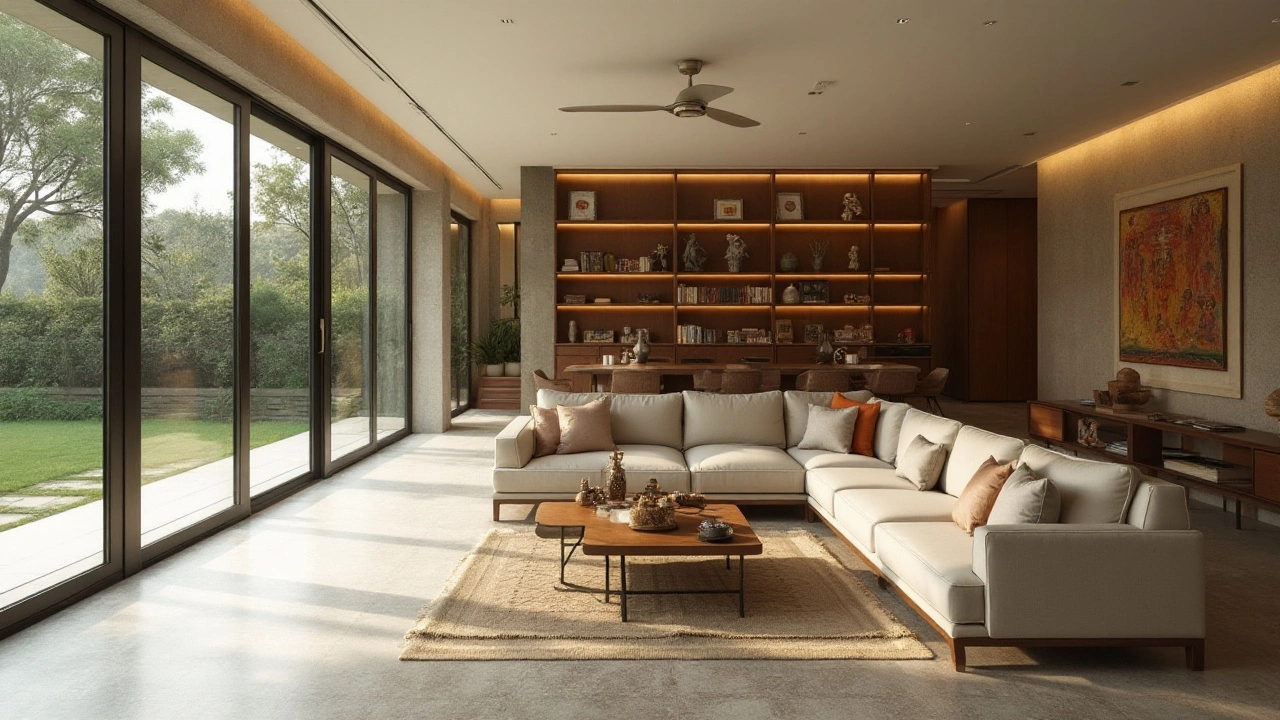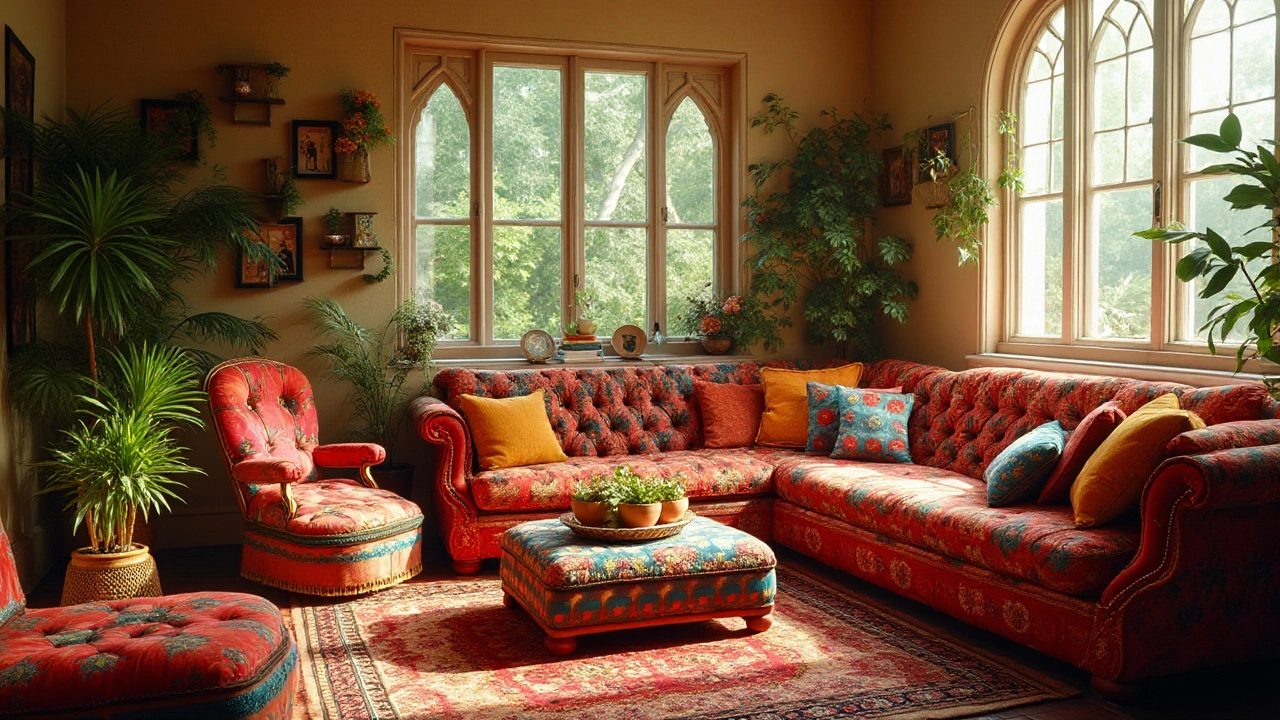In the realm of living room design, furniture placement can deeply influence how spacious or cramped a space feels. Among the choices you make, adding a corner sofa to the mix can dramatically shape the perception of your room's size.
These L-shaped seating arrangements come with their own set of advantages and myths. The question on many minds is: do corner sofas truly make a room look smaller, or can they cleverly create an illusion of space?
Throughout this article, we will delve into the nuances of incorporating corner sofas into your living area, sharing practical advice and debunking common myths along the way.
- Understanding Corner Sofas
- Room Size Perception
- Maximizing Space with Corner Sofas
- Choosing the Right Size and Shape
- Complementing with Decor and Colors
- Common Mistakes and How to Avoid Them
Understanding Corner Sofas
Corner sofas, often referred to as sectional sofas, have become a cornerstone in modern living room design. These versatile pieces of furniture are celebrated for their ability to fit snugly into a room’s corner, effectively optimizing seating capacity without overwhelming the space. Corner sofas typically feature an L-shape or a U-shape configuration, offering a cosy and communal seating arrangement that is perfect for families or social gatherings. What makes these sofas particularly appealing is their modular nature; they can often be customized or reconfigured to suit diverse spatial needs and aesthetic preferences.
There are several things to keep in mind when choosing a corner sofa, starting with their dimensions. It's crucial to measure your living space accurately to ensure the sofa will fit comfortably without obstructing doorways or windows. In smaller rooms, opting for a compact corner sofa or one with sleek, low-arm designs can help maintain an open and airy feel. Materials and colors are important too. A light fabric or leather finish can make the room feel brighter and more spacious, countering the potential for small spaces to feel cramped. To balance style with function, consider sofas that include storage options in their base for an efficient use of space.
From a design perspective, corner sofas can also serve as the focal point of a room. They naturally create a corner where you can integrate complementary decor elements, such as a standing lamp, a small side table, or a vivid plant, enhancing the room's visual interest. An intriguing fact about these sofas is their ability to bridge the gap between modern and traditional design styles, making them suitable for diverse interior decors. As interior designer Nate Berkus aptly puts it,
“A good sofa should bring together the style of the room and reflect the personality of those who live in it.”This sentiment captures the essence of choosing a corner sofa that not only fits but also enhances the overall ambiance of your home.
Another noteworthy aspect is their role in open-plan spaces where defining areas without walls can be challenging. Corner sofas can effectively separate a living room from adjoining spaces, such as dining areas or kitchens, providing a visual boundary while maintaining an open design ethos. This method of space delineation without solid barriers appeals particularly to those who prefer fluidity and ease of movement within their homes.
A common question involves durability and cleaning, a practical consideration in any furniture purchase. Many modern corner sofas come with removable, washable covers, or are treated with stain-resistant fabrics, ensuring longevity even in homes with children or pets. Investing in a well-constructed sofa made from quality materials often pays off in comfort and wear resistance. Before purchasing, evaluate factors like frame strength, cushion firmness, and fabric resilience to find a suitable match for your lifestyle. This attention to detail ensures that your sofa remains a beloved centerpiece for years to come, adeptly balancing both style and practicality.
Room Size Perception
When stepping into a living room, the arrangement of furniture plays a pivotal role in shaping how we perceive the size of the space. To many, adding a corner sofa might seem like a bold move in a modest-sized room, sparking concerns about it swallowing too much floor space. Yet, with the right approach, corner sofas can achieve the opposite effect, acting as anchors that organize the room and make it feel more expansive.
One key factor in room size perception is the furniture's height and structure. Sofas with raised legs create an airy feel by allowing light to flow beneath, creating the illusion of more space. Conversely, low-backed designs help maintain an open view across the room, avoiding the visual clutter that bulky furniture often brings. The L-shape of a corner sofa naturally delineates zones without requiring additional partitions or furniture items that might crowd a space.
"A well-placed corner sofa can unify a room, opening up circulation pathways and defining functional areas. It's about creating a balance between perceived boundaries and open space," notes interior designer Maria Thompson, highlighting the strategic impact of such sofas.
Lighting also plays a crucial role in influencing room perception. Natural light, when complemented by a strategically placed corner sofa, can enhance a room's openness. Mirrors opposite windows can further amplify this effect, bouncing light across the room. Despite their size, corner sofas can actually help streamline visual flow, especially when they are in sync with the room’s light scheme and color palette.
Moreover, materials and color choices pivotal in corner sofa selection can vastly impact spatial perception. Light, neutral tones can expand a room visually, while bold colors create focal points that might shrink a space. Opting for fabrics that reflect light, such as silk or satin, can add to the airy feel, enhancing space perception. Ensuring that your corner sofa complements the existing theme without overpowering the room’s design is essential for maintaining that delicate balance.

Maximizing Space with Corner Sofas
When it comes to arranging a living room, a corner sofa can be a savior, allowing you to make the most of your space. Picture this: you have a cozy apartment or an open-plan lounge, and a corner sofa can become the focal point, guiding the flow and function of the room. The beauty of these sofas is in their flexibility and the way they define corners, previously neglected spots that suddenly gain a purpose. By strategically placing a corner sofa, you can open up the room, make it more inviting, and create natural walkways without overcrowding the space.
It's crucial to align the sofa against walls or in the actual corner of the room. This placement not only saves space but also frames the area, making it feel defined and organized. An L-shaped sofa can act like a built-in structure without the permanence, offering flexibility in design. You can let the lines of the sofa guide where your coffee table, lighting, and accessories should go. Sometimes, people worry that these large pieces might overwhelm, but done right, they draw the eye outward, enhancing the room's depth rather than diminishing it.
One clever tactic is to match the color of the sofa with the walls, which creates a seamless flow that tricks the eye into perceiving more space. Simple as it may sound, choosing larger but fewer furniture pieces can also streamline your room's look. It contrasts against the clutter of numerous small items. Use your corner sofa as a boundary, setting distinct zones in open areas, which is especially beneficial in spaces where the living and dining areas overlap. This method not only makes the room adaptable but marks clear functionality without the need for walls.
"The art of living lies not in eliminating but in growing with contradictions," said the architect Kisho Kurokawa, pointing out how we can embrace the contradictory nature of wanting expansive spaces within our finite dimensions.
Lighting, too, plays a vital role. Install ambient lighting behind the sofa to push back shadows and extend the room's feeling beyond the sofa's outline. With multipurpose or modular styles, corner sofas offer storage solutions that further declutter the space. Consider a unit with hidden compartments or an ottoman with storage limitlessly useful for tidying away throws or remote controls. Incorporate a smartly chosen rug beneath a corner sofa to anchor the space and add texture, promoting both visual and physical comfort.
Furthermore, complement your corner sofa with decor that leads the gaze upwards. High curtains draw attention to the ceiling, increasing the perceived height of the room. Mirrors across from the sofa can reflect light and the room itself, crafting an illusion of extension. Even hanging art gathers attention, setting vertical boundaries that enhance the room's overall expanse. Such design elements work harmoniously to create a lively, spacious ambiance without sacrificing charm and functionality.
Choosing the Right Size and Shape
When selecting a corner sofa for your living area, size and shape are paramount components that determine both functionality and aesthetics. It's easy to underestimate the impact that furniture dimensions have on spatial perception. A key consideration is the balance between filling a room and allowing it to breathe. Furniture that is too large might overwhelm the space, while pieces that are too small can make the room feel unfinished or sparse. Measure the room meticulously before shopping to ensure you find the perfect fit.
Another important factor is the shape of the corner sofa. L-shaped designs are immensely popular for their versatility and ability to act as a room divider in open-concept living spaces. U-shaped sofas, on the other hand, are perfect for families that frequent entertaining. When you have the right dimensions in mind, consider how the sofa's shape complements rest of your furnishings. Take into account how the room functions daily and any specific areas that need to remain accessible. This thoughtful approach not only enhances room usability but also elevates your interior design.
According to interior designer, Emily Henderson, "A corner sofa can anchor a room in ways no other furniture piece can." Henderson suggests envisioning how your sofa will interact with other elements in your space. A helpful trick is to use painter's tape to outline the sofa's footprint right on your floor before making any purchasing decisions. This not only aids in visualizing the sofa's actual size, but also in assessing flow and movement around the room. Aim for at least 18 inches of walkway between the sofa and other objects to maintain an open feeling.
When it comes to materials and colors, choosing the right one can enhance the illusion of space. Opt for lighter shades to expand the perceived size of the room, especially if there is insufficient natural light. Patterns and textures are best left understated to avoid visual clutter. The fabric's durability is another noteworthy factor, particularly if the sofa is set to become a high-traffic seating area. Performance fabrics, which combine resilience with elegance, are gaining traction among homeowners for their practicality without sacrificing style.
- Measure your space accurately.
- Consider the room's primary use when choosing shape.
- Use tape to outline potential pieces for spatial awareness.
- Choose lighter shades for a more open feel.
- Ensure at least 18 inches of space for walkways.
Choosing the right size and shape of your corner sofa can significantly affect how comfortable and welcoming your space feels. It acts as a backbone of your living room, bringing balance between style and functionality. Keeping these tips in mind can make the difference between a room that feels cramped and one that is a stunning, open haven.

Complementing with Decor and Colors
When it comes to styling a room with corner sofas, decor and color choices can significantly impact how the space is perceived. The right selection can enhance the feeling of spaciousness, while a poor choice may lead to a cramped appearance. Start by considering the dominant colors in your room. If your space is small, light and neutral shades often work best to create an airy feel. You could opt for whites, beiges, or soft pastels for both the walls and the corner sofa itself. These colors reflect light, making the room appear larger than it is. Throws and cushions in contrasting but complementary colors can add depth and layers to your design.
Adding decorative mirrors is a clever tactic, and their reflective nature can double the amount of perceived space, almost like opening another window. Hang a large mirror opposite to a window, allowing sunlight to bounce around the room, illuminating every nook and cranny. Incorporating glass and transparent furnishings can maintain openness within the room while still serving a practical purpose. Consider glass coffee tables or acrylic chairs that won't visually clog up the area around your corner sofa.
Choosing art and accessories also plays a crucial role in harmonizing the decor. Large, bold artworks can draw the eye upwards, creating a sense of height and grandeur despite the compact floor footprint. Groupings of small frames can, however, lend to clutter, so keeping the decor minimal and focused will help keep the room feeling unencumbered. If your corner sofa boasts a particular texture or pattern, it might be worthwhile to echo these aspects in smaller decor elements scattered throughout the room, creating a cohesive theme.
Lighting and its Effects
Lighting is another pivotal factor in the illusion of space. Multiple light sources can be more effective than a single, central fixture. Consider a variety of floor lamps, table lamps, and wall sconces to create layers of light that highlight different aspects of your decor. By illuminating the corners and areas behind the corner sofa, you can add depth and dimension, making the entire room feel larger. Use dimmers for adjustable lighting, allowing you to change the mood and perceived room size at different times of the day.Interior designer and author Emily Henderson once said, "A well-placed light fixture can change the look and feel of a room more dramatically than any other single decor element." This highlights the transformative power of lighting, reminding us not to underestimate how much light management contributes to a room's ambiance and functionality.
Lastly, consider the floor's design and color. Dark carpets or floorboards can often shrink a space visually, while lighter tones can broaden the room. If changing the flooring is beyond your current scope, a strategically placed rug can unify the seating area while maintaining a sense of openness with the rest of the room. Remember, the balance and scale of elements around your corner sofa should work synergistically with the furniture's bulk, creating a harmonious and spacious atmosphere.
| Color | Effect on Space |
|---|---|
| Light Neutrals | Makes space feel larger |
| Dark Shades | Can make rooms feel smaller |
| Bold Art | Adds visual height |
Common Mistakes and How to Avoid Them
When integrating a corner sofa into your living room, it's easy to inadvertently make a few missteps that can affect the aesthetics and utility of the space. One of the most frequent errors is choosing a sofa that overwhelms the available space. This can happen when the sofa's dimensions are not in harmony with the room, leading to a cramped appearance rather than a cozy oasis. Measuring the room accurately and understanding the proportions relative to other furniture pieces is crucial. This way, you can opt for a sofa that complements rather than dominates the room, ensuring a balanced and pleasant living space.
Another common mistake is ignoring the flow of traffic in the room. A corner sofa, by design, takes up a significant amount of room, and positioning it poorly can obstruct pathways and impede movement. Ideally, there should be sufficient space around and behind the sofa to allow easy navigation within the living area. This contributes to a sense of openness and accessibility, crucial for maintaining the ambiance of any room. Consider how frequently-used paths in your home, and ensure your layout respects these natural flows.
People often underestimate the importance of lighting when it comes to living room design. A corner sofa, depending on its color and material, can either absorb or reflect light, affecting the room's brightness and mood. Ensure your lighting is optimized to counterbalance the physical presence of your sofa. Consider placing lamps strategically or using wall-mounted fixtures to create layers of light that highlight the sofa as a centerpiece without dimming the room.
Color coordination is yet another element where homeowners might slip. Mismatching the sofa's upholstery with the room’s prevailing theme can lead to visual discord. It's essential to consider the color palette of your living room when selecting a corner sofa. Neutral tones tend to blend more easily into various styles, but a bold hue can also make a statement if paired thoughtfully with complementary colors in decor and accessories.
Layout flexibility is often overlooked as well. Many assume the corner sofa must be permanently anchored to one spot, but rethinking its role in your space can be refreshing. Sometimes, slightly angling the sofa rather than pushing it flush against two walls can add dynamic energy to the room. Don't be afraid to experiment with placing the shorter segment of your L-shaped sofa facing a window or an interesting architectural feature; this can create a focal point that enhances the room's depth.
A final and often disregarded mistake involves the utilitarian aspect of the corner sofas. They can do more than provide seating; many come with storage solutions or modular sections that can be rearranged, applied for different occasions. Not leveraging these features means you might miss opportunities for convenience and customization. When buying, look for options that offer more than just seating, thereby adding multiple layers of functionality to your home decor.

